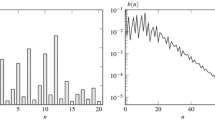Abstract
In this paper we consider a discrete time queueing model where the time axis is divided into time slots of unit length. The model satisfies the following assumptions: (i) an event is either an arrival of typei of batch sizeb i, i=1,...,r with probabilityα i or is a depature of a single customer with probabilityγ or zero depending on whether the queue is busy or empty; (ii) no more than one event can occur in a slot, therefore the probability that neither an arrival nor a departure occurs in a slot is 1−γ−⌆i α i or 1−⌆i α i according as the queue is busy or empty; (iii) events in different slots are independent. Using a lattice path representation in higher dimensional space we will derive the time dependent joint distribution of the number of arrivals of various types and the number of completed services. The distribution for the corresponding continuous time model is found by using weak convergence.
Similar content being viewed by others
References
W. Böhm,Markovian Queueing Systems in Discrete Time, Mathematical Systems in Economics, Vol. 137 (Hain, Frankfurt/Main, 1993).
W. Böhm, and S.G. Mohanty, On discrete time MarkovianN-policy queues involving batches, Sankyā, Ser. A 56 (1994) 1–20.
W. Böhm and S.G. Mohanty, Transient analysis ofM/M/1 queues in discrete time with general server vacations, J. Appl. Prob. (1992), to appear.
W. Böhm and S.G. Mohanty, The transient solution ofM/M/1 queues under (M,N)-policy. A combinatorial approach, J. Statist. Planning Inference 34 (1993) 23–33.
W. Feller,An Introduction to Probability Theory and Its Applications, Vol. 1, 3rd ed. (Wiley, New York, 1968).
H.W. Gould, Some generalizations of Vandermonde's convolution, Amer. Math. Monthly 63 (1956) 84–91.
Kanwar Sen, J.L. Jain and J.M. Gupta, Lattice path approach to transient solution ofM/M/1 with (0,K) control policy, J. Statist. Planning Inference 34 (1993) 68–82.
Kanwar Sen and J.L. Jain, Combinatorial approach to Markovian queues, J. Statist. Planning Inference 34 (1993) 55–67.
Kanwar Sen and J.L. Jain, private communication (1993).
I. Mitrani,Modelling of Computer and Communication Systems (Cambridge University Press, Cambridge, New York, 1987).
S.G. Mohanty, On queues involving batches, J. Appl. Prob. 9 (1972) 430–435.
S.G. Mohanty,Lattice Path Counting and Applications (Academic Press, New York, 1979).
L. Takács,Combinatorial Methods in the Theory of Stochastic Processes (Wiley, New York, 1967).
Author information
Authors and Affiliations
Rights and permissions
About this article
Cite this article
Böhm, W., Mohanty, S.G. Transient analysis of queues with heterogeneous arrivals. Queueing Syst 18, 27–45 (1994). https://doi.org/10.1007/BF01158773
Received:
Revised:
Issue Date:
DOI: https://doi.org/10.1007/BF01158773




